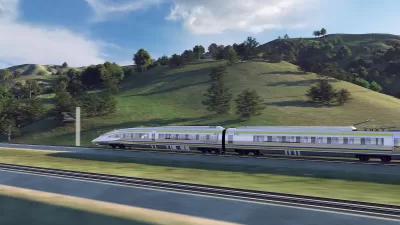The San Jose to Merced Project Section Final Environmental Impact Report/ Environmental Impact Statement could be approved by April 21.

The California High-Speed Rail Authority (CAHSRA) on February 25 released the Final Environmental Impact Report/Environmental Impact Statement for a key section of the California High-Speed Rail Project in Northern California.
The EIR/EIS for the approximately 90-mile section of the route connecting San Jose to Merced Project in Northern California will be under consideration for approval at a two-day board meeting on April 20 and 21, according to a press release from CAHSRA published on February 25.
"In the San Jose to Merced Project Section, high-speed trains will travel through or near the cities of Santa Clara, San Jose, Morgan Hill, Gilroy and Los Banos, connecting Silicon Valley and the Central Valley," according to the press release. "The proposed preferred alternative alignment would include upgrading existing rail lines between San Jose and Gilroy and constructing a new high-speed rail alignment with more than 15 miles of tunnels through Pacheco Pass in the Diablo Range."
Roger Rudick had the scoop on the final EIR/EIS in an article for Streetsblog California, calling the San Jose to Merced Project Section an "all-important connection." Boris Lipkin, Northern California regional director for the project, is quoted in the article calling the EIR/EIS a big milestone for the project. Rudick's coverage includes more detail on the recent history of planning and politics on the project.
FULL STORY: California High-Speed Rail Releases Final Environmental Studies to Connect Silicon Valley and Central Valley

Alabama: Trump Terminates Settlements for Black Communities Harmed By Raw Sewage
Trump deemed the landmark civil rights agreement “illegal DEI and environmental justice policy.”

Study: Maui’s Plan to Convert Vacation Rentals to Long-Term Housing Could Cause Nearly $1 Billion Economic Loss
The plan would reduce visitor accommodation by 25% resulting in 1,900 jobs lost.

Why Should We Subsidize Public Transportation?
Many public transit agencies face financial stress due to rising costs, declining fare revenue, and declining subsidies. Transit advocates must provide a strong business case for increasing public transit funding.

Paris Bike Boom Leads to Steep Drop in Air Pollution
The French city’s air quality has improved dramatically in the past 20 years, coinciding with a growth in cycling.

Why Housing Costs More to Build in California Than in Texas
Hard costs like labor and materials combined with ‘soft’ costs such as permitting make building in the San Francisco Bay Area almost three times as costly as in Texas cities.

San Diego County Sees a Rise in Urban Coyotes
San Diego County experiences a rise in urban coyotes, as sightings become prevalent throughout its urban neighbourhoods and surrounding areas.
Urban Design for Planners 1: Software Tools
This six-course series explores essential urban design concepts using open source software and equips planners with the tools they need to participate fully in the urban design process.
Planning for Universal Design
Learn the tools for implementing Universal Design in planning regulations.
Smith Gee Studio
Alamo Area Metropolitan Planning Organization
City of Santa Clarita
Institute for Housing and Urban Development Studies (IHS)
City of Grandview
Harvard GSD Executive Education
Toledo-Lucas County Plan Commissions
Salt Lake City
NYU Wagner Graduate School of Public Service





























